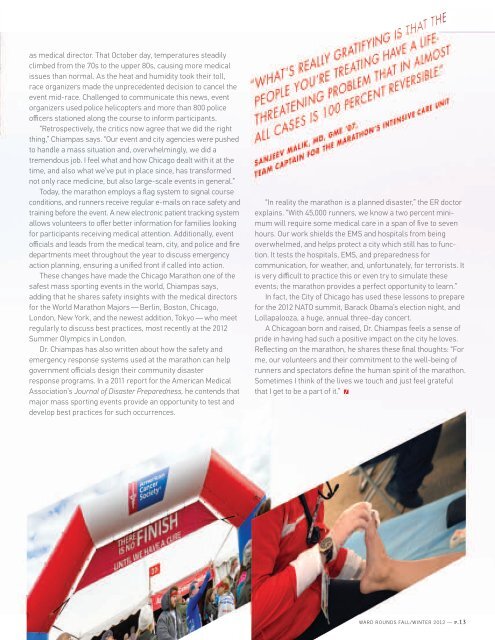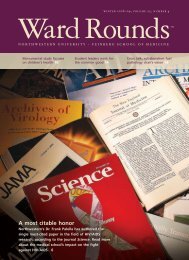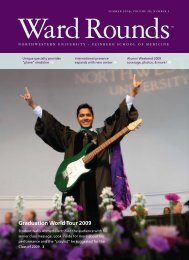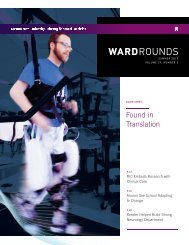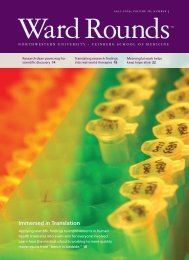Download PDF - Ward Rounds - Northwestern University
Download PDF - Ward Rounds - Northwestern University
Download PDF - Ward Rounds - Northwestern University
Create successful ePaper yourself
Turn your PDF publications into a flip-book with our unique Google optimized e-Paper software.
as medical director. That October day, temperatures steadily<br />
climbed from the 70s to the upper 80s, causing more medical<br />
issues than normal. As the heat and humidity took their toll,<br />
race organizers made the unprecedented decision to cancel the<br />
event mid-race. Challenged to communicate this news, event<br />
organizers used police helicopters and more than 800 police<br />
officers stationed along the course to inform participants.<br />
“Retrospectively, the critics now agree that we did the right<br />
thing,” Chiampas says. “Our event and city agencies were pushed<br />
to handle a mass situation and, overwhelmingly, we did a<br />
tremendous job. I feel what and how Chicago dealt with it at the<br />
time, and also what we’ve put in place since, has transformed<br />
not only race medicine, but also large-scale events in general.”<br />
Today, the marathon employs a flag system to signal course<br />
conditions, and runners receive regular e-mails on race safety and<br />
training before the event. A new electronic patient tracking system<br />
allows volunteers to offer better information for families looking<br />
for participants receiving medical attention. Additionally, event<br />
officials and leads from the medical team, city, and police and fire<br />
departments meet throughout the year to discuss emergency<br />
action planning, ensuring a unified front if called into action.<br />
These changes have made the Chicago Marathon one of the<br />
safest mass sporting events in the world, Chiampas says,<br />
adding that he shares safety insights with the medical directors<br />
for the World Marathon Majors — Berlin, Boston, Chicago,<br />
London, New York, and the newest addition, Tokyo — who meet<br />
regularly to discuss best practices, most recently at the 2012<br />
Summer Olympics in London.<br />
Dr. Chiampas has also written about how the safety and<br />
emergency response systems used at the marathon can help<br />
government officials design their community disaster<br />
response programs. In a 2011 report for the American Medical<br />
Association’s Journal of Disaster Preparedness, he contends that<br />
major mass sporting events provide an opportunity to test and<br />
develop best practices for such occurrences.<br />
“In reality the marathon is a planned disaster,” the ER doctor<br />
explains. “With 45,000 runners, we know a two percent minimum<br />
will require some medical care in a span of five to seven<br />
hours. Our work shields the EMS and hospitals from being<br />
overwhelmed, and helps protect a city which still has to function.<br />
It tests the hospitals, EMS, and preparedness for<br />
communication, for weather, and, unfortunately, for terrorists. It<br />
is very difficult to practice this or even try to simulate these<br />
events; the marathon provides a perfect opportunity to learn.”<br />
In fact, the City of Chicago has used these lessons to prepare<br />
for the 2012 NATO summit, Barack Obama’s election night, and<br />
Lollapalooza, a huge, annual three-day concert.<br />
A Chicagoan born and raised, Dr. Chiampas feels a sense of<br />
pride in having had such a positive impact on the city he loves.<br />
Reflecting on the marathon, he shares these final thoughts: “For<br />
me, our volunteers and their commitment to the well-being of<br />
runners and spectators define the human spirit of the marathon.<br />
Sometimes I think of the lives we touch and just feel grateful<br />
that I get to be a part of it.”<br />
ward rounds Fall/Winter 2012 — p.13


